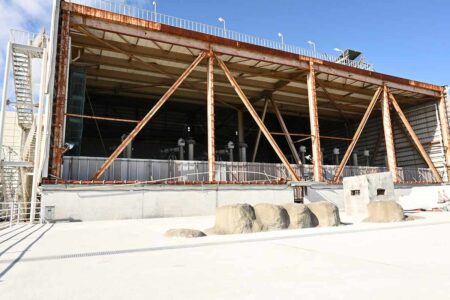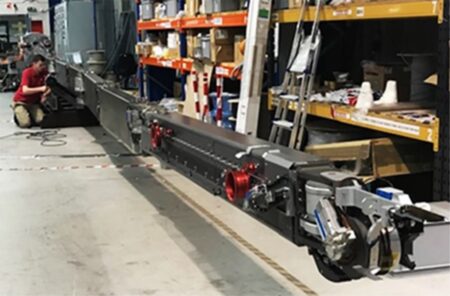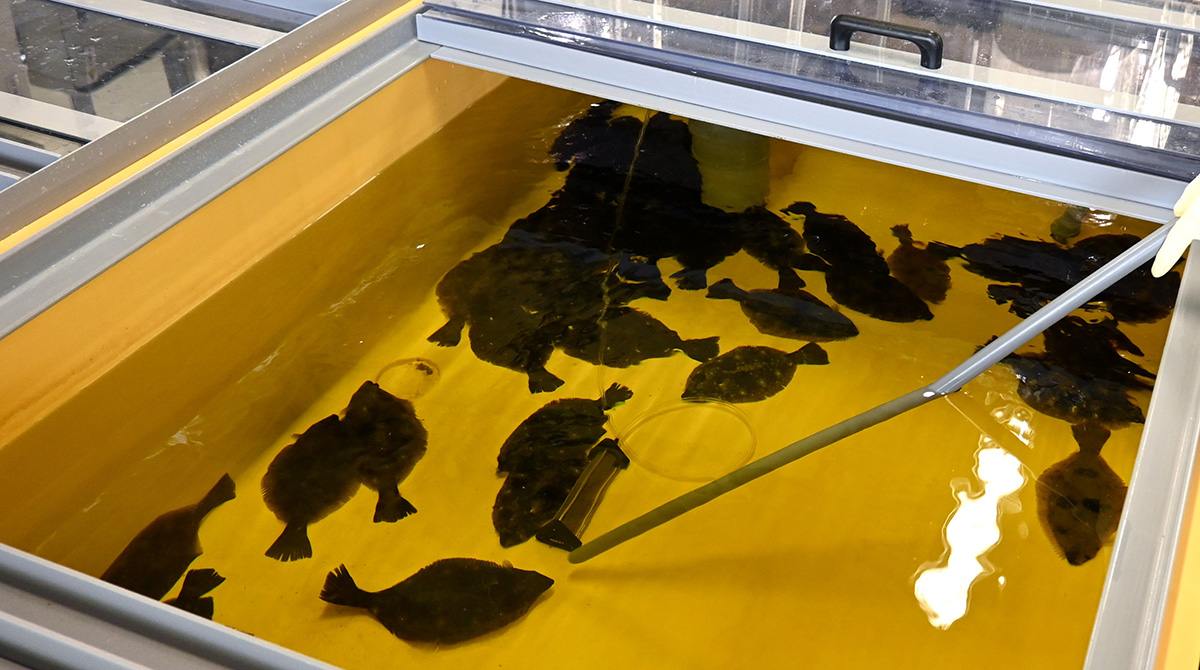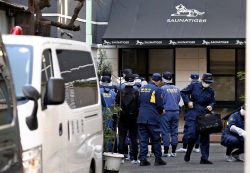Decommissioning Fukushima / Nuclear Fuel Debris to be Removed, Tested in FY23

Reactor Unit 1, in the background, sits with the rebar exposed at the Fukushima No. 1 nuclear power plant.
13:13 JST, February 8, 2023
Exposed to the cold midwinter winds were the rebar on top of the Tokyo Electric Power Co. (TEPCO) reactor building, nearly 12 years after the hydrogen explosion of the Unit 1 reactor at the Fukushima No. 1 nuclear power plant. This image seemed to convey the severity of the accident and the difficulty of the decommissioning work, which will continue for several decades.
When I visited the site on Jan. 26, decommissioning was underway in Units 1 and 2. The work involved investigations to remove the fuel rods that remain in the fuel pool and the fuel debris, which includes nuclear fuel that had melted and solidified as a result of the core’s meltdown. An important step is planned for Unit 2: the first experimental removal of fuel debris, targeting the latter half of fiscal 2023.
On higher ground facing Unit 1 was an observation deck that offered a panoramic view of Units 1-4, where the nuclear accident occurred. Each unit continues to be in cold shutdown.
According to TEPCO, the concentration of radioactive materials around the plant has been reduced to less than one-millionth of the level immediately after the accident. Most of the debris that was scattered around the area after the accident has been removed, and behind the observation deck there is a facing that prevents rainwater from seeping into the ground.

Part of the facing behind the observation deck
Looking down from the deck, I saw staff at work around Units 1 and 2. This observation deck was not there about 10 years ago, when I last visited. With the sea to the east in front of me, the view extends from Unit 1 to Unit 4 to the right. For security reasons, it is forbidden to take photos of the entire area.
“The reactor building looks damaged with exposed rebar, but we have confirmed that the lower part of the building remains earthquake-resistant,” said an official of TEPCO Holdings while looking at Unit 1. “It can withstand the direct installation of a structure weighing about 8,000 tons.”
The official was referring to the work in progress to install large plates on the walls of the Unit 1 building. The entire building, including the top part where the rebar is exposed, is to be wrapped in a large cover before the debris removal work will proceed.
There are still 392 fuel rods in Unit 1 and 615 in Unit 2 in the spent fuel pools. The removal of 566 rods from Unit 3 and 1,535 rods from Unit 4 have already been completed. The fuel pools of each unit are located on the top floor of the reactor building, and in Unit 1, debris remains on top of the fuel pool.
The walls of the Unit 1 building were blown off by the hydrogen explosion, however. If work begins in the current open-air state, dust might be scattered and radioactive materials could spread to the surrounding area.
“There are residents who have returned to their homes, and we must not cause them any concern,” said the TEPCO official.
Because of this ongoing preparatory work at Unit 1, the actual removal of fuel rods is scheduled to begin in fiscal 2027-28. It will be the last of the four units to have the fuel rods removed. TEPCO aims to complete fuel rod removal from all six units at the nuclear plant by the end of 2031. Units 5 and 6 are further north and suffered little damage from the Great East Japan Earthquake and tsunami that struck on March 11, 2011.
-

Construction of a platform for test removal of fuel debris is underway at Unit 2, which escaped a hydrogen explosion.
-

A schematic image of the Unit 2 platform
-

A switchyard that connected and disconnected the link to the power grid to send the electricity generated by Units 1 and 2
Unit 2 was the only one among units 1 to 4 to escape a hydrogen explosion. The impact of the hydrogen explosion in neighboring Unit 1 caused the panels on the side of the Unit 2 building to open, allowing hydrogen to escape.
Because of this situation, however, radiation levels inside remain high. In order to begin removing the fuel rods here, it is necessary to lower the radiation level inside the building, so the working environment has been improved by, for example, laying iron plates on the floor. A platform is currently being constructed on the south side of the Unit 2 building for work to begin between fiscal 2024 and 2026.

A part of a platform sits on a dolly before it will be attached to Unit 2.
A huge structure that will be part of the platform was sitting in a different part of the site. Equipped with thick piping, this part of the substructure was already complete and on a dolly, waiting to be attached to Unit 2.
“In order to shorten the work time at the site, we are assembling it at another location before transporting it,” the official in charge said.
Indeed, there is a wide road leading straight out from that location toward the sea. Following this road leads right next to Unit 1.
World watching closely

A British-made robotic arm that moves like an inchworm (Courtesy of TEPCO)
Another important step is the removal of fuel debris from inside the reactor container.
“The debris will be removed using a British-made robotic arm that moves like an inchworm,” the official in charge explained. “An about 60-centimeter diameter hatch on the reactor containment vessel will be opened and the robotic arm will be inserted from there.”
The arm, which can extend up to 22 meters, will be remotely operated as it moves through the complex containment vessel. Since fuel debris has piled up at the bottom of the vessel, the tip of the arm extends a bit further down to grab fuel debris.
I understood, however, that it would not be easy to remove all the fuel debris that had piled up in large quantities. Fuel debris is the nuclear fuel in the reactor core that has melted down at temperatures of over 1,200 C, mixed with various surrounding devices and materials, and cooled down and solidified at the bottom of the containment vessel. The shapes of these materials vary, including pebble-shaped ones that easily crumble and clumped ones that are difficult to cut out. The method of removal will probably vary depending on the characteristics of each piece of debris.
-

A full view of the robotic arm (Courtesy of TEPCO)
-

Pumps to draw groundwater before it flows into the basement of the reactor building
-

Entrance of a shed housing groundwater pumps
TEPCO is preparing to remove fuel debris from the Unit 2 container for the first time on a trial basis in the latter half of fiscal 2023, meaning sometime from October through March 2024. The amount is likely to be only a few milligrams out of the more than 200 tons of fuel debris in the Unit 2 container, but it will be a major step forward.
Improvements, such as modifications of the robot arm’s control program, are being made and training is being conducted at a facility in the nearby town of Naraha.
A room is also being built in the Unit 2 building to isolate the reactor containment vessel when the hatch is opened.
In Unit 1, an underwater robot is being used to investigate the inside of the vessel. The massive amount and thickness of the sediment were measured in June last year.
An investigation inside the reactor containment vessel of Unit 3 also confirmed sediment and structures that are believed to have melted down, while in Unit 4, there was no fuel in the reactor because all of it had been removed to the fuel pool during a routine inspection.
The removal of fuel debris has not started even 12 years after the accident. This is about two years later than the original schedule in the medium- to long-term road map for decommissioning.
This is largely because there was a period when materials could not be transported from the United Kingdom and staff could not come to Japan due to the COVID-19 pandemic. However, I feel that the important thing is not the road map but the steady progress of decommissioning while ensuring safety.

These containers at the site hold various types of waste, including used protective clothing. The building in the rear is the new storage building.
Technological advances may make something possible in the future, if not possible now, or may require fundamental changes in methods. With the world watching closely, the never-before-experienced decommissioning work will continue. I felt that Japan, which has suffered an unprecedented nuclear accident, must complete the safe decommissioning of the Fukushima No. 1 nuclear power plant.
Japanese version
福島第一原発で続く廃炉作業の厳しい現実、燃料デブリの取り出しはいつになる
"JN Specialities" POPULAR ARTICLE
-

The Japan News / Weekly Edition (12/12-12/18)
-

English-language Kabuki, Kyogen Entertain Audiences in Tokyo; Portland State University Professor Emeritus, Graduates Perform
-

Noodle Dining Shunsai / Rich Oyster Ramen to Savor at Odasaga; Experienced 68-year-old Owner Creates Numerous Ramen Varieties
-

The Japan News / Weekly Edition (12/5-12/11)
-

People Keep Loved Ones’ Ashes Close in Special Jewelry, Small Urns as Unique Way to Memorialize Them
JN ACCESS RANKING
-

Keidanren Chairman Yoshinobu Tsutsui Visits Kashiwazaki-Kariwa Nuclear Power Plant; Inspects New Emergency Safety System
-

Imports of Rare Earths from China Facing Delays, May Be Caused by Deterioration of Japan-China Relations
-

University of Tokyo Professor Discusses Japanese Economic Security in Interview Ahead of Forum
-

Tokyo Economic Security Forum to Hold Inaugural Meeting Amid Tense Global Environment
-

Japan Pulls out of Vietnam Nuclear Project, Complicating Hanoi’s Power Plans






























